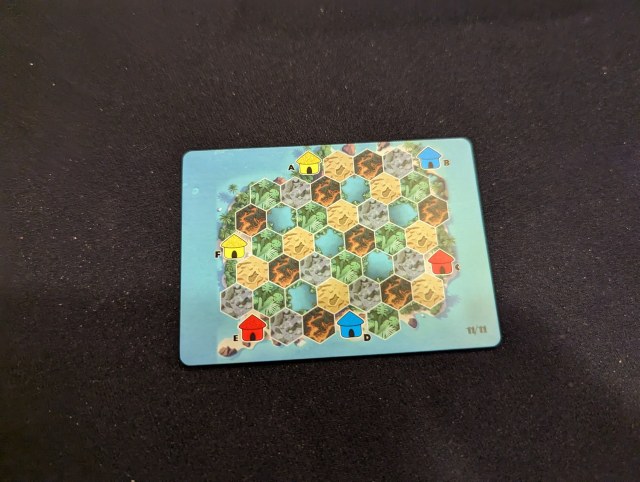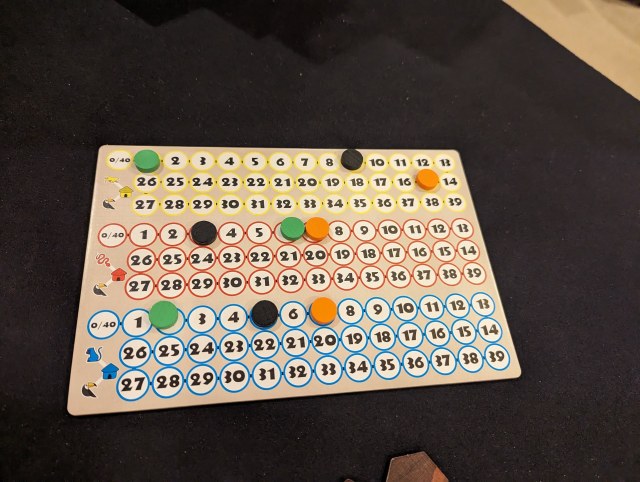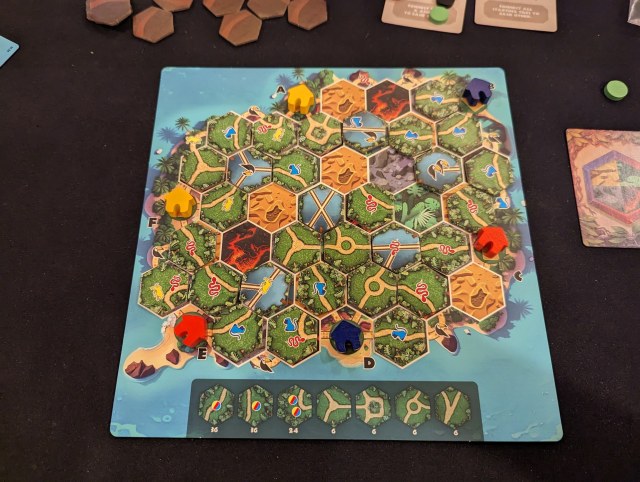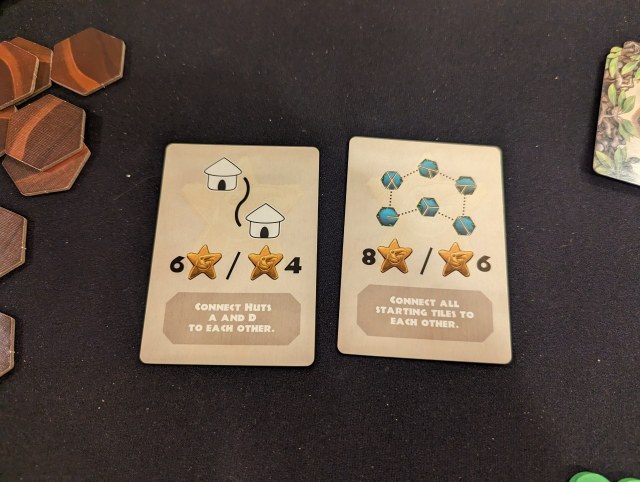Tucana Builders
- Designers: Eilif Svensson and Kristian A. Østby
- Publisher: Aporta games
- Players: 1-5
- Age: 10+
- Time: 30 minutes
- Played with review copy provided by Aporta Games / Matagot
Tucana Builders is a sequel to the award winning Trails of Tucana. Place tiles on spaces that match the revealed terrain card to connect animals to corresponding huts. All connections that score in round 1 will score again in round 2. So, do you go for high scores in round 1, or will you try to create smart intersections for long-term benefits? Tucana Builders is an easy-to-teach game for those who enjoy challenging tile-laying puzzles.
—description from the publisher
In Tucana Builders, the animals on your island have scattered due a volcanic eruption, and you must build paths to get all the animals home. Each player is given one of the player boards, 2 huts of each color, a set of starting tiles, and a wild card.. A setup card and 6 Starting cards are flipped up and each player places their huts and starting tiles on the board as directed. The 120 path tiles and the deck of terrain cards are shuffled. There is a scoreboard with three different tracks (yellow, red, and blue) – each player places one marker on each track. Advanced players can also deal out two achievement cards at random.
The game is played over 2 rounds, with each having 12 turns. To start a turn, the top Terrain Card from the deck is flipped over, then all players draw a random facedown Path tile and then must place that tile on any matching terrain space on their board. Once per round, a player may use his Wild card to choose any type of terrain to place upon instead of the one dictated by the Terrain Card.
The overall goal is to connect animals to a matching hut. Blue monkeys want to go to the blue hut, Yellow Pumas want to go to the yellow huts, and red Snakes unsurprisingly want to go the red huts. The Toucan is wild and is happy at any color hut. If you are playing with the achievement cards, also check after each round if you have met the requirement on either card. If so, place a scoring marker on that Achievement. Players that do this first get a higher score, while players who do it on a later turn will take the lower score.
At the end of the first round – after 12 turns, and it will be easy to remember when as the Terrain Deck will be exhausted – there is a round of scoring. Score each of the three tracks separately. First, score yellow – taking 1 point for each puma or toucan connected to a yellow hut. Next, red – taking 1 point for each snake or toucan connected to a red hut, and finally blue – taking 1 point for each monkey or toucan connected to a blue hut. If an animal is connected to both huts of a color, it scores twice. Toucans can also score for each hut they are connected to.
Repeat the process for the second round. Shuffle the Terrain deck, reset the Wild cards, and reveal one Terrain card each turn. When all twelve turns are complete, score again with the same criteria.
The player with the highest total score wins (from the three score tracks and the achievement cards if you used them). Ties broken in favor of the highest minimum score (that is the best score for a player’s worst color).
There is also a solo version which works very similar to the multiplayer game. You must use the achievement cards, and you score the higher value if you achieve the goal in the first round, and the lower value if you achieve it in the lower round. And… if you don’t complete them both, you automatically lose. Otherwise, you shoot for the highest score possible.
My thoughts on the game
Tucana Builders takes an interesting path – the original Trails of Tucana was a roll and write, and this is a full board relative of that game. Usually, games go the other direction – starting as a full table game and then being converted to a roll and write version. As I’ve noted in the past, I’ve been a big fan of all the RAW games from Aporta (going all the way back to Doodle City), so I was definitely curious to see how things would work out.
is a nice puzzly game that I have really liked so far. It is engaging and quick, and you really have to be both skillful and lucky to succeed. The setup seems convoluted when you first read the rules, but trust me, once you’ve done it once, it’s actually quite intuitive and easy to do. The goal of setup is to give an equal start, but one that is likely different from any previous games.
The rest of the rules are honestly dead simple – I can teach the game in about 2 minutes building a few examples with tiles on my board before everything gets shuffled up for the setup. And as long as one person understands the setup, that’ll be enough to get everyone ready to play.
Once the game starts, you’re in your own world – for the most part at the mercy of the Terrain Deck, though you do get one Wild card play per round. If you use it wisely, you might be able to make a lot of connections through a well placed piece. Of course, as things go, you may just be lucky and not need it at all – I have actually played one game so far where I didn’t need to use my Wild in either round; each turn gave me a pretty good placement with the allotted Terrain.
Unlike some other simultaneous play games, you do get a random draw of a Path tile – so that everyone’s board will look quite different in the end. For each Terrain type, there are 8 different possible locations on your board, and each player will almost certainly have a different tile to place on a given turn. That being said, luck of the draw can play a huge part in your overall success (or failure) as there are definitely tiles which are advantageous to get at certain times of the round, and you’ll need to have luck on your side to draw the right combination of tiles with branching pathways as well as tiles with the animal you desire on them.
As you are building your paths, you should remember that you will have 8 empty spaces at the end of the game – there are 32 empty spaces at the start of the game, and you’re only going to have 24 turns. While it seems like you could just neglect one portion of the map, the way that the huts are located evenly around the board makes it unlikely that you’d want to do that. Additionally, given the way the tiebreaker goes, I don’t know if you’d want to completely abandon one hut of a color as you’d likely get a very low score in that color – though as this is only the tiebreaker, maybe it’s a decent strategy…
The Achievement cards are a nice addition for me, they increase the level of complexity a slight bit – but having that one extra thing to think about makes the game much more interesting. I could certainly see leaving it out with beginners or children; but for my game group, including these cards is a must.
Games are pretty quick; though there will be times when someone/everyone has to ponder the map for a bit as they try to figure out where to place tiles. I have found that the random pull of tiles from the supply keeps me from over thinking. Generally, I just try to find places that have good potential of matching up to paths found on future tiles; but since I don’t have any way of knowing what those tiles will be – just put stuff down and let future me worry about it later… The slowest part of the game is actually the scoring! It can be really hard to track down which animals are on what paths. I’ve actually started keeping a bag of cubes around and I place a cube on each animal as I count it for a hut so that I don’t miss any nor double count any. The scoring can be so difficult that I know it has turned at least one or two gamers here off the game.
I think I actually prefer this version over the original roll-and-write; mostly because I like having the physical bits to play with. The player boards are a nice thick coated cardstock, and the tiles are sturdy and came out easily from the punchboards. The wooden huts are brightly painted and remind me of the German games I played when I started in the hobby back in the 1990s. My only quibble with the components is the box insert. It works great for shipping as it keeps the punchboards flush to the top of the box, but there is literally not even half the volume you need to hold all the punched hexes in after you’ve played the game. Only after a few plays did I realize that you can fold up parts of the insert to make pseudo-boxes to hold the material inside. (It would have been nice for the rulebook or the insert to hint at this!)
Tucana Builders is a great path building puzzle that I would heartily recommend to anyone. As it is essentially simultaneous solitaire, it works fine with any player count, and I have enjoyed it greatly as a solo game as well.
Ratings from the Opinionated Gamers
- I love it!
- I like it. Dale Y, John P, Steph H.
- Neutral.
- Not for me…






